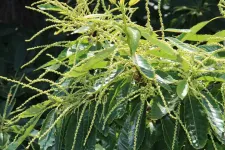(Press-News.org) Phase 1/2 clinical trial of CoronaVac in 550 children and adolescents aged 3-17 years in China suggests two doses of the vaccine are safe and generate a strong antibody response.
First published data on safety and immune response generated by a COVID-19 vaccine in children as young as 3-years-old supports use of CoronaVac - which was recently approved for emergency use in China among children over 3-years-old - in further studies to inform immunisation strategies.
Two doses of CoronaVac are safe and provoke a strong antibody response among children and adolescents aged 3-17 years, according to a randomised controlled trial of 550 young people published in The Lancet Infectious Diseases journal.
More than 96% of children and adolescents who received two doses of the vaccine - manufactured by Sinovac - developed antibodies against SARS-CoV-2. Most adverse reactions were mild or moderate, with pain at the injection site the most commonly reported symptom.
Qiang Gao, of Sinovac Life Sciences Co, Ltd, China, said: "Children and adolescents with COVID-19 usually have mild or asymptomatic infections compared with adults; however, a small number may still be at risk of severe illness. They can also transmit the virus to others, making it vital to test the safety and effectiveness of COVID-19 vaccines in younger age groups. Our finding that CoronaVac was well tolerated and induced strong immune responses is very encouraging, and suggests that further studies in other regions, involving larger, multi-ethnic populations, could provide valuable data to inform immunisation strategies involving children and adolescents." [2]
The authors conducted a randomised, double-blind, controlled phase 1/2 clinical trial of CoronaVac in healthy children and adolescents aged 3-17 years in Zanhuang County, China. Between October 31 and December 2, 2020, 72 participants were enrolled in phase 1, with 480 participants enrolled in phase 2 between December 12 and December 30, 2020. The vaccine (either 1.5μg or 3μg per dose) or a control was given by intramuscular injection in two doses, at day 0 and day 28. In studies involving adults aged 18-59 years and people aged 60 years and older, participants received two doses of 1.5μg, 3μg, or 6μg, with 3μg doses suggested for use in further research. [1]
Among the 550 participants who received at least one dose of vaccine or the control, adverse reactions within 28 days occurred in 56 (26%) of 219 participants in the 1.5μg group, 63 (29%) of 217 in the 3μg group, and 27 (24%) of 114 in the control group. Most adverse reactions were mild or moderate, with pain at the injection site (13%, 73/550 participants) the most commonly reported symptom. Only one serious adverse reaction - a case of pneumonia - was reported in the control group; however, this was unrelated to the COVID-19 vaccination.
In phase 1, 100% of participants in both the 1.5μg and 3μg groups (27/27 and 26/26 participants, respectively) generated antibodies against SARS-CoV-2. Stronger immune responses - determined by the amount of antibodies produced that can neutralise the virus, expressed as geometric mean titre (GMT) - were detected among the 3μg group compared with the 1.5μg group (GMTs of 117 and 55, respectively). In phase 2, 97% (180/186) of participants in the 1.5μg group produced antibodies against SARS-CoV-2, compared with 100% (180/180 participants) in the 3μg group. Participants in the 3μg group again produced a stronger immune response that those in the 1.5μg group (GMTs of 142 and 86, respectively). Similar to findings for other vaccines that increasing age is linked with reduced immune responses, the authors note that immune responses among children and adolescents were higher than those in adults aged 18-59 years and elderly aged 60 years and older (GMTs of 44 and 42, respectively). [1]
No significant differences in immune response were detected in an analysis by age group, with more than 93% of those in the 1.5μg and 3μg groups aged 3-5 years, 6-11 years, and 12-17 years producing antibodies against SARS-CoV-2 (with GMTs ranging from 78 to 146) at day 28 after the second dose. In each age group, there were significant differences in GMTs between the 1·5 μg and
3·0 μg groups after the second dose, except in the group aged 12-17 years old in phase 1.
Based on their results, the authors recommend two 3μg doses of the vaccine for children and adolescents aged 3-17 years.
The authors acknowledge some limitations to their study. T cell responses - which play an important role in SARS-CoV-2 infections - were not assessed in the study, though these have been investigated in related studies. The study involved a small number of participants and all were of Han ethnicity, highlighting a need for larger studies in other regions and involving multi-ethnic populations. Long-term safety and immune response data were not available, though participants will be followed for at least 1 year. Owing to the small number of participants in the study, the results should be interpreted with caution as it was not possible to draw strong statistical conclusions.
Writing in a linked Comment, Professor Bin Cao, of the China-Japan Friendship Hospital, China, highlights the need to include children in immunisation campaigns, explaining: "Herd immunity against COVID-19 is the prerequisite to end this pandemic, either through vaccinations or natural infection. Most estimates placed the threshold at 65-70% of the population gaining immunity, mainly by vaccination. However, widely circulating virus variants and persistent hesitancy on vaccine make this threshold difficult to reach. (...) Thus, the calculation has to be revised upward and children must be covered in the immunisation campaign."
In calling for longer follow-up assessments in children, Professor Cao also emphasises the vital importance of determining the safety of vaccines in younger age groups, saying: "While vaccinating children is essential to reach herd immunity and limit the severity of COVID-19, safety should be the paramount factor to be considered before COVID-19 vaccines can be rolled out in younger children."
INFORMATION:
NOTES TO EDITORS
This study was funded by the National Key Research and Development Program and the Beijing Science and Technology Program. It was conducted by researchers from Hebei Provincial Center for Disease Control and
Prevention, Sinovac Biotech Ltd, National Institutes for Food and Drug Control, Zanhuang County Center for Disease Control and Prevention, Beijing Key Tech Statistics Technology Co., Ltd., and Sinovac Life Sciences Co, Ltd, China.
[1] https://www.thelancet.com/journals/laninf/article/PIIS1473-3099(20)30987-7/fulltext and https://www.thelancet.com/article/S1473-3099(20)30843-4/fulltext
[2] Quote direct from author and cannot be found in the text of the Article.
The labels have been added to this press release as part of a project run by the Academy of Medical Sciences seeking to improve the communication of evidence. For more information, please see: http://www.sciencemediacentre.org/wp-content/uploads/2018/01/AMS-press-release-labelling-system-GUIDANCE.pdf if you have any questions or feedback, please contact The Lancet press office pressoffice@lancet.com
NOTE: THE ABOVE LINK IS FOR JOURNALISTS ONLY; IF YOU WISH TO PROVIDE A LINK FOR YOUR READERS, PLEASE USE THE FOLLOWING, WHICH WILL GO LIVE AT THE TIME THE EMBARGO LIFTS: http://www.thelancet.com/journals/laninf/article/PIIS1473-3099(21)00319-4/fulltext
Peer-reviewed / Randomised Controlled Trial / People
In first-of-its kind research led by a University of Massachusetts Amherst psychotherapy researcher, mental health care patients matched with therapists who had a strong track record of treating the patients' primary concerns had better results than patients who were not so matched.
In addition, this "match effect" was even more beneficial and pronounced for patients with more severe problems and for those who identified as racial or ethnic minorities.
The findings are published in JAMA Psychiatry and the Journal of Consulting and Clinical Psychology.
"One of the things we've been learning in our field ...
PULLMAN, Wash. - A research team led by Washington State University has created a computer model to understand how plants store energy in the thylakoid membrane, a key structure to photosynthesis in plant leaves.
The team confirmed the accuracy of the mathematical model with lab experiments. Their work was recently published in the journal Nature Plants.
"We provided an important piece to the overall puzzle of plant metabolism," said Helmut Kirchhoff, a professor in WSU's Institute of Biological Chemistry and leader of the team who made this discovery. "If we integrate our model into the bigger picture, it may provide a good path for how to improve plants for ...
Two recent collaborative publications by CU Cancer Center members provide insights into how chronic inflammation can serve as a key factor in the development of leukemia and other blood cancers.
Eric Pietras, PhD, CU Cancer Center member and assistant professor in the CU School of Medicine Division of Hematology, and James DeGregori, PhD, deputy director of the CU Cancer Center and professor in the Department of Biochemistry and Molecular Genetics, were corresponding authors on both papers.
Both papers provide support for the theory of adaptive oncogenesis, which was developed by DeGregori. The theory stipulates that chronic inflammation (such ...
AMES, Iowa - During the course of a criminal investigation, it is common for investigators to interview individuals who are exhausted and have had little sleep. While unavoidable in some cases, a new Iowa State University study found sleep disruption or deprivation may limit the amount of information provided during an interview.
The study, published in the academic journal SLEEP, is one of the first to look at how sleep affects behavior during interrogations or interviews. Zlatan Krizan, an ISU professor of psychology, says while beliefs about the impact of sleep on interrogation subjects have existed for decades, he and co-authors, ISU professor Christian Meissner and graduate student Anthony Miller, found little direct scientific evidence related to its effectiveness. Krizan ...
A new national study finds that children in the United States with greater screen time usage at ages 9-10 are more likely to gain weight one year later.
The study, publishing in Pediatric Obesity on June 28, found that each additional hour spent on virtually all forms of screen time was associated with a higher body mass index (BMI) one year later. In particular, researchers found that each extra hour spent watching or streaming television, YouTube videos, video games, video chat, and texting led to a higher risk of weight gain one year later. At the start of the study, 33.7% of children were considered overweight ...
Scientists isolated a molecule, extracted from the leaves of the European chestnut tree, with the power to neutralize dangerous, drug-resistant staph bacteria. Frontiers in Pharmacology published the finding, led by scientists at Emory University.
The researchers dubbed the molecule Castaneroxy A, after the genus of the European chestnut, Castanea. The use of chestnut leaves in traditional folk remedies in rural Italy inspired the research.
"We were able to isolate this molecule, new to science, that occurs only in very tiny quantities in the chestnut leaves," says Cassandra Quave, senior author of the paper and associate professor in Emory's Center for the Study of Human Health and the School of Medicine's ...
COLUMBUS, Ohio -- Mountaintop glacier ice in the tropics of all four hemispheres covers significantly less area -- in one case as much as 93% less -- than it did just 50 years ago, a new study has found.
The study, published online recently in the journal Global and Planetary Change, found that a glacier near Puncak Jaya, in Papua New Guinea, lost about 93% of its ice over a 38-year period from 1980 to 2018. Between 1986 and 2017 the area covered by glaciers on top of Kilimanjaro in Africa decreased by nearly 71%.
The study is the first to combine NASA satellite imagery with data from ice cores drilled during field expeditions on tropical ...
Cunjiang Yu, Bill D. Cook Associate Professor of Mechanical Engineering at the University of Houston, is reporting the development of a camera with a curvy, adaptable imaging sensor that could improve image quality in endoscopes, night-vision goggles, artificial compound eyes and fish-eye cameras.
"Existing curvy imagers are either flexible but not compatible with tunable focal surfaces, or stretchable but with low pixel density and pixel fill factors," reports Yu in Nature Electronics. "The new imager with kirigami design has a high pixel fill factor, before stretching, of 78% and can retain its optoelectronic performance while being biaxially stretched by 30%."
Modern digital camera systems using conventional rigid, flat imaging sensors require ...
The world's human population is expanding, which means even more agricultural land will be needed to provide food for this growing population. However, choosing which areas to convert is difficult and depends on agricultural and environmental priorities, which can vary widely.
A study led by Princeton University illustrates this challenge by using several different approaches to solve the same puzzle: Given a target amount of food, where should new croplands be put to minimize environmental or biodiversity impacts?
The researchers used the country of Zambia as a case study given that it currently harbors a significant ...
PHILADELPHA--Patients who had their wisdom teeth extracted had improved tasting abilities decades after having the surgery, a new Penn Medicine study published in the journal Chemical Senses found. The findings challenge the notion that removal of wisdom teeth, known as third molars, only has the potential for negative effects on taste, and represent one of the first studies to analyze the long-term effects of extraction on taste.
"Prior studies have only pointed to adverse effects on taste after extraction and it has been generally believed that those effects dissipate over time," said senior author Richard L. Doty, PhD, ...





